 W
WAnsembourg Old Castle, known as the Old Castle of Ansembourg, in central Luxembourg is one of the castles belonging to the Valley of the Seven Castles. Located high above the little village of Ansembourg, the medieval castle is the private residence of the current Count and Countess of Ansembourg.
 W
WThe New Castle of Ansembourg, in central Luxembourg is one of the castles belonging to the Valley of the Seven Castles. Located about one kilometre or just over half a mile below the Old Castle of Ansembourg, it was built by the industrialist Thomas Bidart in 1639.
 W
WAspelt Castle, located in Aspelt in the south of Luxembourg, is a Baroque residence built in 1590 on the site of a medieval castle from the 11th century. There are now plans to renovate the building.
 W
WBeaufort Castle dating from the 11th century consists of the ruins of the medieval fortress and an adjacent Renaissance château. It is located in Beaufort in eastern Luxembourg.
 W
WThe Embassy of Russia in Luxembourg is the diplomatic mission of the Russian Federation to the Grand Duchy of Luxembourg. The mission is located in the historic Château de Beggen.
 W
WBerg Castle, also called Colmar-Berg, is the principal residence of the Grand Duke of Luxembourg. It is situated in the town of Colmar-Berg, in central Luxembourg, near the confluence of the Alzette and the Attert, two of Luxembourg's most important rivers.
 W
WBettange-sur-Mess Castle is located in the village of Bettange-sur-Mess near Dippach in the southwest of Luxembourg. Built in 1753 by René Louis de Geisen, the castle has changed ownership several times. Since 1996, it has been a retraining centre for mentally handicapped persons run by the Association des Parents d’Enfants Mentalement Handicapés.
 W
WBettembourg Castle located in the centre of Bettembourg in the south of Luxembourg has a history starting in 1733 when it was built as the residence of a farming family. Today it houses the offices and services of the local commune.
 W
WBettendorf Castle is located in the village of Bettendorf in eastern Luxembourg. While there appears to have been a castle from the 13th century, today's Baroque building dates from 1728 and was restored in 1962. The castle is privately owned and cannot be visited.
 W
WBorn Castle is located in the centre of the little village of Born some 8 km north of Wasserbillig in south-eastern Luxembourg. It has a history dating from 1286 when the Lords of Born lived there. In particular, they were associated with the families of Hattstein, Faust d'Aschaffenbourg and de Villers. Today's castle was built on the old site in the 18th century and is privately owned.
 W
WBourglinster Castle is located in the village of Bourglinster in central Luxembourg some 17 km (11 mi) to the east of Luxembourg City. Now housing a restaurant and facilities for business and cultural gatherings, the castle has a history stretching back to the 11th century.
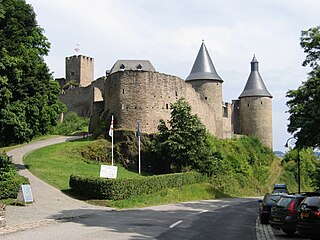 W
WBourscheid Castle is located near the village of Bourscheid in north-eastern Luxembourg. The medieval castle stands on a site with archeological evidence of structures dating back to Roman times. Standing majestically some 150 metres (490 ft) above the River Sûre, it is enclosed by a circular wall with 11 watchtowers.
 W
WBrandenbourg Castle, now a ruin, is located on a promontory some 70 metres above the village of Brandenbourg in north-eastern Luxembourg. It has a history going back to the 9th and 10th centuries when there was a wooden fort on the site. The 13th century keep, now 11.9 metres high, used to have four floors, only three of which remain. In 1668, the French attacked the castle which subsequently fell increasingly into ruin. It is now owned by the Luxembourg State.
 W
WThe Château de Septfontaines is located in the Rollingergrund district of Luxembourg City. Now a listed building, it has been associated over the years with Luxembourg's Villeroy & Boch porcelain factory, which closed in 2010.
 W
WClemency Castle is located in the little town of Clemency which is close to the Belgian border in south-eastern Luxembourg. The small residential castle adjacent to the church was built in the 1660s in the Renaissance style. It had fallen into disrepair but was fully renovated in 2009 and is occasionally open to the public.
 W
WClervaux Castle in the town of Clervaux in Northern Luxembourg dates back to the 12th century. Destroyed by the fire in the Second World War during the Battle of the Bulge, the castle has now been fully rebuilt. It houses the commune's administrative offices as well as a museum containing an exhibition of Edward Steichen's photographs.
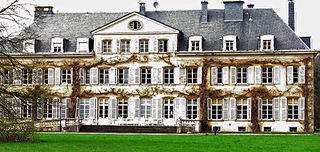 W
WColpach Castle, located in Colpach-Bas near Ell in western Luxembourg, dates from the beginning of the 14th century when it was a stronghold. It was adapted as a manor house in the 18th century. Today it is a 60-bed medical facility for post-oncological and physical rehabilitation owned and operated by the Red Cross via its Fondation Emile Mayrisch.
 W
WDifferdange Castle, located on a hill in the centre of Differdange in southern Luxembourg, was built in 1577 although an earlier fortified castle of Differdange dates from around 1310. Today's residential château is used by Miami University.
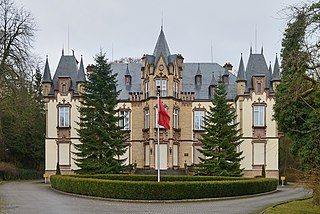 W
WDommeldange Castle is located in Dommeldange, the most northerly quarter of Luxembourg City in the Grand Duchy of Luxembourg. Initially a private residence built for the owner of the local iron works, it is now the Embassy of the People's Republic of China.
 W
WThe ruins of Dudelange Castle are located on Mont St Jean, a forested hill to the west of Dudelange in the south of Luxembourg. The castle was completed in the early 16th century but was destroyed in 1552.
 W
WThe Embassy of Russia in Luxembourg is the diplomatic mission of the Russian Federation to the Grand Duchy of Luxembourg. The mission is located in the historic Château de Beggen.
 W
WErpeldange Castle, located in the town of the same name in north-eastern Luxembourg, now houses the administrative offices for the Commune of Erpeldange, with its grounds open to the public. It has a history dating back to the 13th century.
 W
WEsch-sur-Sûre Castle, now a ruin, is located on a spur in the small town of Esch-sur-Sûre in the north-west of Luxembourg. It is naturally protected by a sharp meander in the River Sûre which surrounds the town and the castle on three sides.
 W
WFischbach Castle is a castle in Luxembourg. It is situated near the town of Fischbach, in central Luxembourg.
 W
WFort Thüngen is a historic fortification in Luxembourg City, in southern Luxembourg. It is sited in Dräi Eechelen Park, in the Kirchberg quarter, in the north-east of the city. It is also colloquially known as Three Acorns in reference to the acorns that sit atop each of the three towers.
 W
WThe Grand Ducal Palace is a palace in Luxembourg City, in southern Luxembourg. It is the official residence of the Grand Duke of Luxembourg, and where he performs most of his duties as head of state of the Grand Duchy.
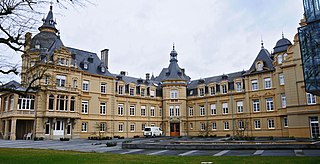 W
WHeisdorf Castle located in the village of Heisdorf in central Luxembourg was built by Baron Lippmann in the late 19th century. Surrounded by a large park, it was designed by the Belgian architect Charles Thirion. In 1916, the Sisters of the Christian Doctrine acquired the property as a convalescent home for their community. In 1982, it was opened as an old people's home under the name of Maison de retraite Marie-Consolatrice. In 2007, a new wing was added to the building by the architecture firm Hermann, Valentiny and Partners providing improved facilities for its senior citizens.
 W
WHollenfels Castle, with a history dating back to the 11th century, is one of the castles located close to the River Eisch in the Valley of the Seven Castles in central Luxembourg. Today it is used as a centre for activities for young people, including a nearby youth hostel.
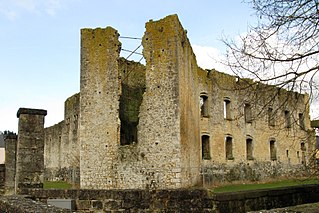 W
WKoerich Castle is a ruin located in the village of Koerich in central Luxembourg. With a history dating back to the 12th century, it is one of the castles in the Valley of the Seven Castles.
 W
WLa Fontaine Castle is the name of a former castle in Clausen, Luxembourg. The elaborate building was the residence of Peter Ernst I von Mansfeld-Vorderort, governor of Luxembourg, who began its construction in 1563 and continued to extend it until his death in 1604. For this reason, it is also known as the Palais Mansfeld or Mansfeld Palace. Almost nothing remains of it to this day.
 W
WLarochette Castle stands high above the town of Larochette in central Luxembourg. Dating from the 11th century, the castle was destroyed by fire at the end of the 16th century. Since its acquisition by the State of Luxembourg in 1979, some restoration work has been undertaken.
 W
WMamer Castle is the town hall for the commune of Mamer, in south-western Luxembourg. It is the home of the communal council, the site of local government offices, and the centre of administration for communal services.
 W
WMersch Castle in central Luxembourg is one of the castles belonging to the Valley of the Seven Castles. Located in the centre of Mersch, its history goes back to the 13th century. Today the castle houses the administrative offices of the local commune.
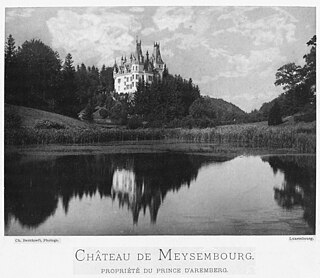 W
WMeysembourg Castle is located some 2 km south-west of Larochette in central Luxembourg. While the site has a history dating back to the 12th century, today's castle was built in 1880 in Neo-Renaissance style and is privately owned.
 W
WMunsbach Castle is located to the southwest of Munsbach near Schuttrange in central Luxembourg. It now belongs to the Institut Universitaire International Luxembourg which provides educational courses in business, European law and public sector management.
 W
WMusée Dräi Eechelen is a museum in the Kirchberg district of Luxembourg City in the Grand Duchy of Luxembourg. Opened in July 2012 in the fully restored 18th-century Fort Thüngen, its permanent exhibition traces Luxembourg's history from 1443 to 1903.
 W
WPettingen Castle is located in the village of Pettingen some 4 km north of Mersch in central Luxembourg. It is one of the best preserved fortified castles in the country.
 W
WThe Tudor Museum, also known as Rosport Castle, is located in the little town of Rosport in north-eastern Luxembourg. Built in 1892, it was the home of the Luxembourg inventor Henri Tudor. Since May 2009, the castle has housed the Tudor Museum.
 W
WSanem Castle, located in the village of Sanem near Esch-sur-Alzette in south-western Luxembourg has a history dating back to the 13th century. Today's building was completed in 1557 after the medieval castle had been partly destroyed. The castle still maintains much of its original character.
 W
WSchauwenburg Castle in Bertrange in south-western Luxembourg has a history dating back to the Middle Ages when, according to historical references from the early 13th century, the Lords of Bertrange occupied a fortified castle. Today's building originated in the 16th century as testified by the Renaissance windows on the eastern and northern wings, the façade being completed in 1710. Around 1780, the d'Huart family who lived in the castle found the facilities too small and constructed a larger building, the Château de Colnet d'Huart, in the vicinity. Over the year, the Schauwenburg Castle has had many different owners and has been used for a variety of purposes. Since 2008, it has temporarily housed the Commune's administrative offices and served as the town hall.
 W
WSchengen Castle is located in the village of Schengen in the south-east of Luxembourg close to the borders with France and Germany. Dating from 1390 but almost completely rebuilt in the 19th century, it was a hotel and conference centre until it was sold to Regus in 2016.
 W
WSchoenfels Castle, with a history dating back to the 12th century, is one of the castles belonging to the Valley of the Seven Castles in central Luxembourg. Located in the village of Schoenfels in the Mamer Valley between Kopstal and Mersch, it now belongs to the State of Luxembourg.
 W
WSchuttbourg is a castle in Luxembourg. It is located near the town of Kautenbach, above the left bank of the Clerve. Since 1997, It has been owned by Ferdinand Feltgen, who has plans to restore the grounds.
 W
WSenningen Castle is a revival-style castle, located in the town of Senningen, in the west of the commune of Niederanven, in the Grand Duchy of Luxembourg. Today it is used by the State for official meetings.
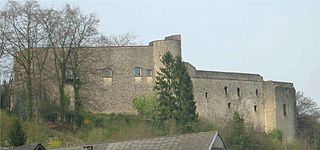 W
WSeptfontaines Castle in central Luxembourg is one of the castles belonging to the Valley of the Seven Castles. Located high above the village of Septfontaines, the medieval castle is now privately owned.
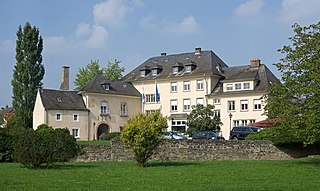 W
WStadtbredimus Castle, located on the banks of the Moselle in the village of Stadtbredimus in south-eastern Luxembourg, has a history going back to the 13th century when a fortified castle stood on the site. In 1724, today's castle was built on the ruins of the old fort and, after some questionable restoration work, was bought by the la Fontaine family in 1802. It was here that Luxembourg's national poet, Edmond de la Fontaine, better known as Dicks, lived from 1858 to 1881.
 W
WStolzembourg Castle is located on a hill in the centre of the village of Stolzembourg in north-eastern Luxembourg. The current building was built on the ruins of the medieval castle in 1898 in the style of a Scottish country house.
 W
WThe Tudor Museum, also known as Rosport Castle, is located in the little town of Rosport in north-eastern Luxembourg. Built in 1892, it was the home of the Luxembourg inventor Henri Tudor. Since May 2009, the castle has housed the Tudor Museum.
 W
WUrspelt Castle is located in the little village of Urspelt some 3 km north-east of Clervaux in northern Luxembourg. Though the castle has a history going back at least three centuries, today's building dates from 1860. After comprehensive restoration work and additions, it recently opened as a hotel and meeting centre.
 W
WUseldange Castle is a medieval castle, now mainly in ruin, located in the village of Useldange in western Luxembourg. The site can be visited throughout the year with special arrangements for poorly sighted visitors.
 W
WVianden Castle, located in Vianden in the north of Luxembourg, is one of the largest fortified castles west of the Rhine. With origins dating from the 10th century, the castle was built in the Romanesque style from the 11th to 14th centuries. Gothic transformations and trimmings were added at the end of this period. A Renaissance mansion was added in the 17th century but thereafter the castle was allowed to fall into ruins. It has, however, recently been fully restored and is open to visitors.
 W
WWalferdange Castle, located in the small town of Walferdange in central Luxembourg, dates from 1824 when William I of the Netherlands who was also Grand Duke of Luxembourg built it as a stud farm. It was a part of the University of Luxembourg and since 2015 has been used by Ministry of National Education, Childhood and Youth (Luxembourg).
 W
WWiltz Castle, located in Wiltz in the north of Luxembourg, dates back to 1573. It is now known above all for hosting an annual music festival. Part of the castle now serves as the campus of United Business Institutes and of BBI.
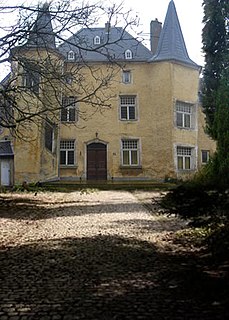 W
WWintrange Castle, located in the centre of Wintrange near Schengen in south-eastern Luxembourg, is a privately owned Renaissance style castle built in 1610 and can be rented for weddings, events, film, and photo location.